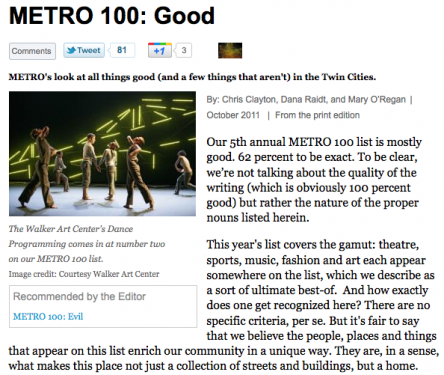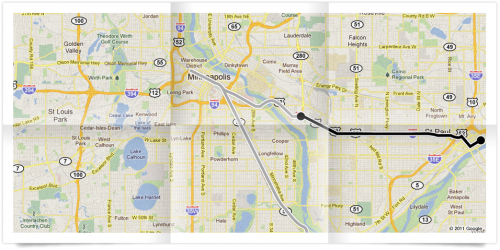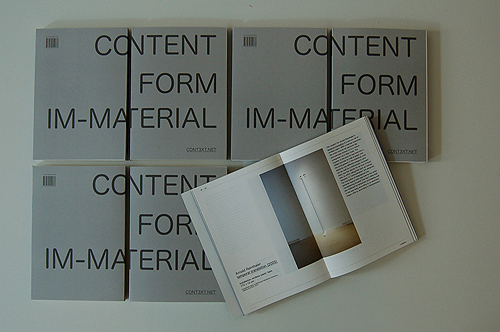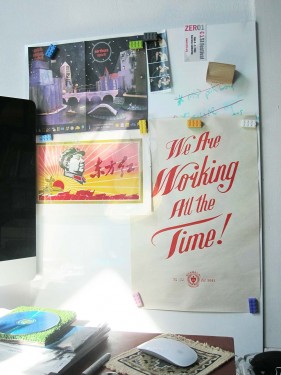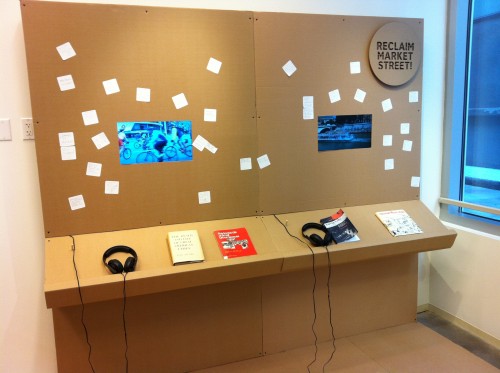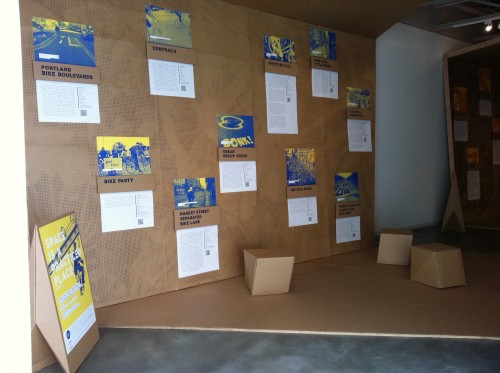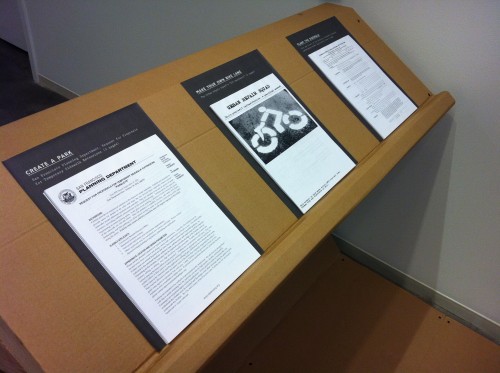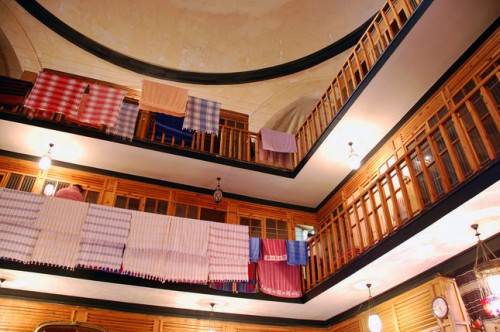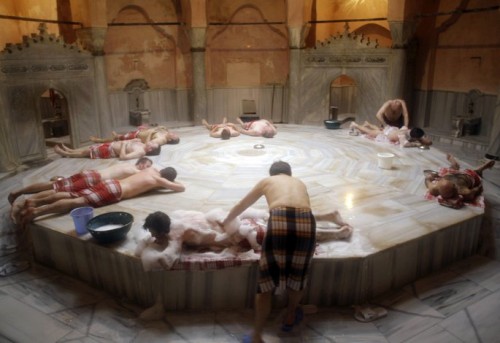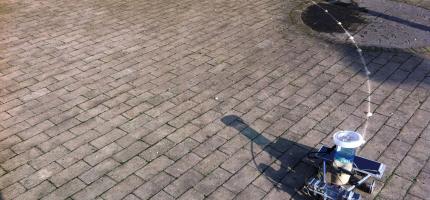Mississippi River Bridge Plaza Design Competition
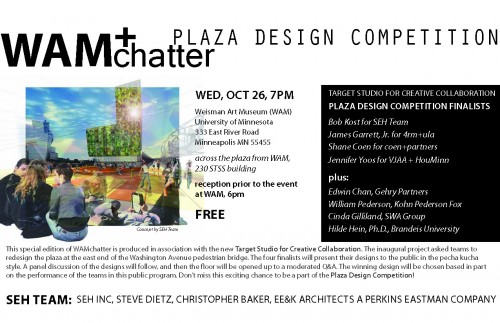
Join us for the Pecha Kucha for the Mississippi River Bridge Plaza Design Competition (Weisman Plaza)
Back in March, the Target Studio for Creative Collaboration at the Weisman Art Museum put out a call for a Mississippi River Bridge Plaza Design Competition. Northern Lights.mn teamed up with Short Elliott Hendrickson (Bob Kost, team leader, and Rachel Baudler), EE&K Architects (Peter Cavaluzzi), and artist Christopher Baker, and we were selected as one of four finalist teams.

The broad outlines of all four teams’ (4rm+ula), coen+partners, and VJAA + HouMinn) proposals are currently on view in the Target Studio at WAM. On Wednesday, October 26, we will present our final proposals to an expert jury in the afternoon and to the public at large at WAMChatter. Final selection of will be announced the following day.
Join us Wednesday, October 26 at 7 pm for 24 minutes of exciting pecha kucha by the 4 cross-disciplinary teams about the Mississippi River Bridge Plaza Design Competition at WAMChatter (preceding reception at 6 pm).
Check out the blog of our team’s “discussions.”
SEH/EE&K/Northern Lights.mn/Christopher Baker team members
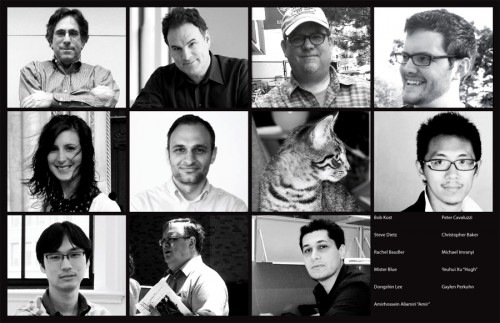
Bob Kost (SEH), Peter Cavaluzzi (EE&K), Steve Dietz (Northern Lights.mn), Christopher Baker (SAIC), Rachel Baudler (SEH), Michael Imranyi (EE&K), Mister Blue (SEH), Yehui Xu (EE&K), Dongshin Lee (EE&K), Gaylen Perkuhn (EE&K), Amier Hossein (EE&K)
1st Prize: The possibility of a new world order
“Storefront for Art and Architecture is making a call for submissions for projects and strategies that offer a new, creative and productive way of spatial occupation for public demonstrations and actions in cities throughout the world. Gathering expertise from the various acts of civil occupation throughout the world during the last months, we ask architects, artists and citizens at large to offer their ideas for enabling acts of communication and action between the civil society and the structures of economic and political power.”
Northern Spark 2011
Check out Brennan Vance’s mini-documentary of the 2011 Northern Spark Festival.
Northern Spark #7 on METRO 100 list
7. Northern Spark, June 4 to 5, 2011
“Modeled after nuit blanche events in Paris and St. Petersburg, the Twin Cities’ first-ever all-night art party spanned galleries and green space on both sides of the river (it even spilled into the mighty Miss via a variety show aboard an old paddleboat). The highlight? Artist Jim Campbell’s “Scattered Light” installation at Upper Landing Park in St. Paul: hundreds of glowing glass bulbs strung together to create Northern Spark’s unofficial nightlight. We’ve been catching lots of Z’s in preparation for next summer’s citywide sleepover, which promises to be bigger and better than the first. northernspark.org“
Save the dates: July 9-10, 2012
Northern Spark is produced and presented by Northern Lights.mn with the participation of 60 organizational partners and sponsors.
Irrigate
Participate in Creative Placemaking!
Soon, hundreds of projects led by local artists will bring new life and vibrancy to the Central Corridor Light Rail Line in Saint Paul, thanks to a new partnership between Springboard for the Arts, Twin Cities Local Initiatives Support Corporation and the City of Saint Paul. Called Irrigate, this initiative spurs artist-led creative placemaking spanning the six miles of the Central Corridor Light Rail line in Saint Paul during the years of its construction. This is a unique opportunity that brings together huge infrastructure development, a high concentration of resident artists on both ends of the corridor, a diverse ethnic and cultural mix among the neighborhoods, and a city with a strong track record of artist community engagement. By mobilizing artists to engage in their community, Irrigate will change the landscape of the Central Corridor with color, art, surprise, creativity and fun.
Placemaking is the act of people coming together to change overlooked and undervalued public and shared spaces into welcoming places where community gathers, supports one another, and thrives. Places can be animated and enhanced by elements that encourage human interaction – from temporary activities such as performances and chalked poetry to permanent installations such as landscaping and unique art.
How to Get Involved
If you are an artist – of any level, experience or discipline – who lives, works or has a personal investment in Central Corridor Light Rail Transit (CCLRT) neighborhoods, Irrigate invites you to join the creative placemaking movement! Use your creative talents to have an impact on your neighborhood, your local businesses and organizations, and the light rail corridor. Starting October 22, Irrigate is offering creative placemaking training workshops, after which artists will be eligible for collaborative placemaking project funding through a simple application process. For more details and registration information for Fall 2011 workshops click here (http://tinyurl.com/PMworkshops).
If you are a business, non-profit, community group, or other entity that is has a presence on the light rail corridor in Saint Paul, and would like to connect artists to your work, please contact Peter Haakon Thompson, Project Coordinator, at peter@springboardforthearts.org or 651-789-0679.
If you are a fan of artists and placemaking, revisit the website after October 15! We will have a live map to which anyone can share ideas about where placemaking can happen along the corridor, AND, over time, you can see artist-led projects take shape, find out ways to participate, and discover placemaking activities and sites to visit.
For more information, see www.irrigatearts.org
Other questions, contact Jun-Li Wang, Artist Community Organizer at jun-li@springboardforthearts.org or 651-789-0679.
Five Years of CONT3XT.NET
“[…] Interpretation is an inherent mode of curatorial practice, and CONT3XT.NET must decide, generally in collaboration with the artists but not entirely, how to manifest the form and content of the network recension of any works exhibited. There is not necessarily a correct answer in this process—although there may be wrong ones—but there is a kind of feedback loop between CONT3XT.NET’s interpretive mode and the content of an exhibition, which is both an instantiation of and a theory about their curatorial practice as translation. […]”–Steve Dietz, Introduction
Book launch: Content | Form | Im-material—Five Years of CONT3XT.NET
CONT3XT.NET is a Vienna-based initiative founded in January 2006 by Sabine Hochrieser, Michael Kargl, Birgit Rinagl and Franz Thalmair. Programmatically, this group of artists, curators and authors—their different roles and functions sometimes regarded strictly, sometimes as a fluid continuum—work at the basis of contemporary visual, textual and networked practices. Starting from the idea of the context as the most indecisive and variable but relevant constraint of any situation, the collective reflects upon the spatial, temporal, discursive as well as the institutional framework that conceptual artistic practices (on the Internet and elsewhere) are rooted in today.
artists
Maria Anwander, Anna Artaker, Ruben Aubrecht, Miriam Bajtala, Ryan Barone, Mary-Anne Breeze—aka netwurker, Charles Broskoski, Codemanipulator®, Arend deGryuter-Helfer and Aylor Brown, Gerhard Dirmoser, Aleksandra Domanovic, Reynald Drouhin, Nikolaus Gansterer, Christina Goestl, Jochen Höller, Karl Heinz Jeron and Valie Djordjevic, Michael Kargl, Annja Krautgasser, Miriam Laussegger and Eva Beierheimer, Jan Robert Leegte, Ralo Mayer, Michail Michailov, MTAA—M. River & T. Whid Art Associates, Barbara Musil and Karo Szmit, Jörg Piringer, Lisa Rastl, Arnold Reinthaler, Veronika Schubert, Johanna Tinzl and Stefan Flunger, UBERMORGEN.COM, Martin Wattenberg and Marek Walczak
authors
Josephine Bosma, Mary-Anne Breeze—aka netwurker, Sarah Cook, Steve Dietz, Thomas Dreher, Constant Dullaart, Mark E. Grimm, Jeremy Hight, Sabine Hochrieser, Michael Kargl, Jan Robert Leegte, Mia Makela, Peter Mörtenböck and Helge Mooshammer, Stefan Nowotny, Les Liens Invisibles, Birgit Rinagl, Franz Thalmair, Pall Thayer, Marius Watz
“We Are Working All the Time!” Wants You
Hope this message finds you well.
If you have visited with the Empty Words (so that we can do our living) performance during the Northern Spark festival on June 4-5, chances are you have walked away with one of the “We Are Working All The Time!” posters. These posters were printed during the performance and distributed to the audience. I am writing to ask you a simple favor:
If you have that poster hanging somewhere, would you please take a quick photo of it in whatever environment it is, and send the image to me?
I started this simple site for this poster series, and my hope is to show the posters in various spaces, where people chose to hang them.
http://weareworkingallthetime.org
There are not too many images there yet, but with your help I am hoping to populate the site very soon!
Thank you for your help,
p.
PS
If you know anyone else that has this poster, or if you saw one around, please forward this message to them!
Reclaim Market Street!
Reclaim Market Street! is an exhibition and series of public programs created by the Studio for Urban Projects and hosted by SPUR (the San Francisco Planning + Urban Research Association), in San Francisco, CA.
Studio for Urban Projects is an art and design collaborative that, according to their website, “perceives art as a means of advancing civic engagement and furthering public dialogue.” Together, the Studio’s core members–Alison Sant, Richard Johnson, Marina McDougall, Kirstin Bach and Daya Karam–operate a storefront in the Mission District of San Francisco and have created public art projects for the city of Seattle, and the 2010 01SJ Biennial.
This research-based exhibition largely consists of a curated set of examples of public projects and interventions that have had positive impacts in other cities that is held together by a clever exhibition design consisting largely of cardboard–cardboard seats, walls, signage, kiosks, and even flooring. The meat of the project lies in its public programs of walking tours, guided bike rides, impromptu parks, and outdoor events that challenge the public to participate in redefining what they expect from (and how they interact with) city streets.
Indoors, I found the way the exhibition challenges people to take immediate action most refreshing. Within SPUR are work stations displaying applications where you can immediately apply to “Create a Park,” “Make Your Own Bike Lane” or “Plant the Sidewalk.” Outdoors, their project is about gathering people together to acknowledge history while contributing to aspirational scenarios of the future.
This project is a perfect example of how artists are using their practice to help create solutions to real-world problems. Market Street is the central transit corridor of San Francisco. On one side is Ferry Plaza and the bustling Financial District, on the other side is the colorful Castro District where shops and cafes line the street. In the middle is the Central Market District. Originally a theater district, years of economic decline have left it more known for strip clubs, panhandlers, graffiti, and empty storefronts. The City of San Francisco has launched a revitalization campaign and other organizations such as the San Francisco Arts Commission and Gray Area Foundation for the Arts have been actively working to literally bring art to the street.
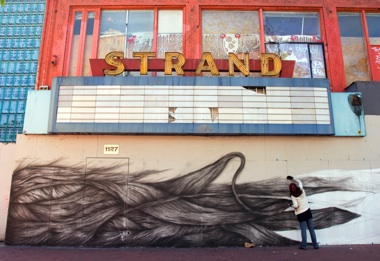
Paz de la Calzada painting Central Market Dreamscape, 2011. Mural, 1127 Market Street, San Francisco. Courtesy of the ARTery Project, San Francisco Arts Commission. Photo: Lydia Gonzales.
Reclaim Market Street! adds to this local dialogue and is about using Market Street as muse in a public conversation around expand the use cases for city streets beyond automobile traffic to include safe and engaging spaces for bikers and pedestrians. Because Central Market Street District is a place people are more likely to pass through quickly, Studio for Urban Projects has created a framework that challenges people to spend time on the street. A particularly interesting program that will take place on October 15th is “Temporary Urban Experiments in Creating New Public Spaces.” Child-friendly urban planning more often than not sequesters children within fenced off playgrounds. But what if play was incorporated back into street life?
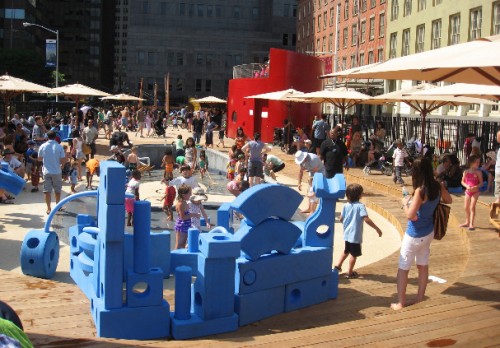
The Imagination Playground installed near South Street Seaport in New York City. Image courtesty of http://www.glenwoodnyc.com/
For this project, they are featuring the Imagination Playground Kit designed by David Rockwell and the Rockwell Group within an urban plaza that is normally dominated by concrete.
With public funds for the arts dwindling, revitalization of cities through the arts and culture is one area that is receiving greater attention in recent times. As an example, the NEA is echoing this call for a revitalization of cities through the arts by recently announcing its inaugural “Our Town” grants that help 51 communities, including San Francisco and San Jose, CA, revitalize their neighborhoods through strategies involving the arts. Creative placemaking is a challenge to reclaim our urban centers, which is precisely what Studio for Urban Projects is doing in focusing their energies toward the Central Market Street District.
Much of what Studio for Urban Projects suggests is common sense. Safe and scenic bike paths through the city, reclamation of under utilized spaces, and a move away from automobile centric civic design. It’s the thoughtfulness of the exhibition design and their collaborative ethos (Reclaim Market Street! also showcases contributions by Futurefarmers, Rebar, and the San Francisco Bike Coalition) that works best in using the arts to promote conversations that have the potential to create lasting change.
So the question is, what urban spaces would you like to reclaim?
Times Square
Bruce Charlesworth: ISEA.2
I bought my ticket, a yellow plastic tab, and was given a small cardboard box. A cluster of topless Turkish men in plaid towels gestured toward one of the narrow staircases. I climbed to the second level balcony where I was ushered into a wooden cubicle. I stripped down, wrapped a towel around my waist and stepped into some plastic sandals. The attendant asked for the yellow tab, then locked the room and handed me the key.
Clutching the cardboard box and key, I went back down the stairs to the lobby, where my burly masseur, Ahmet, met me and shook my hand. After a quiz to determine my correct nationality, he led me into the cooling-down room. He removed a small scrub mitt from the box, handed it to me and pointed to the interior of the empty box. For a moment I thought he was about to do a conjuring trick, but then he pointed inside the box again, rubbed his thumb and forefinger together and said the word “token”. I pantomimed that all I had was a mitt, key and towel. No hidden lira or euros. He rolled his eyes, slapped me manfully on the shoulder and said: “later!”
Pointing toward the edge of the huge marble platform beneath the hot room dome, Ahmet guided me to lay on my back with my head on a small spittoon-like metal headrest, and then left me to sweat for fifteen minutes. The heat and humidity from the platform was intense, eventually almost hallucinatory as I stared upward at the terracotta dome perforated by round holes. Every few seconds, a drum-like boom seemed to come from deep inside the walls.
Ahmet returned and started splashing me with buckets of hot water, had me sit up, roll over, stand and lie down again. Next I could feel a softness glide over me and looked down to see soapsuds drifting upward over my shoulders and neck. Ahmet began to scrub me all over, in different positions, stopping to point out an accumulation of dead skin on one of my arms. I was doused with hot water again, massaged, taken into the cool-down room where he washed and kneaded my head.
Ahmet splashed me with cold water and returned me to the hot room. Pointing to the marble platform, he gave me terse one and two-word instructions to lie down for no less than ten minute, take a shower, dry off with a towel, go upstairs and dress, come down and give the token there. Not upstairs. Down.
Related Posts
Bruce Charlesworth is an artist, writer and filmmaker. He one of the pioneers of postmodern staged photography and among the first artists to use video and audio to power aspects of physically immersive “narrative environments.” He teaches in the Department of Film/Video/New Genres at the University of Wisconsin Peck School of the Arts in Milwaukee. He previously reported on Ars Electronica in 2009 for Public Address.
The Street Fair
Waste Not
We are still getting in final documentation of Northern Spark. There is a great photo essay of the event here. Above is video documentation of Christopher Baker’s Waste Not. The projection visualizes in real time time a data dump of the garbage that accumulates every day in Minneapolis. And while not yet part of the public interface, the project is programmable to isolate and visualize various aspects of the waste stream from diapers to plastic.
Baker is also currently showing Murmur Study, at Pace Gallery in New York, a work first commissioned for the Art(ists) on the Verge program.
Bruce Charlesworth: ISEA.1
Arriving late Thursday night in Istanbul after a full day of teaching and a drive from Milwaukee to catch my connecting flight to Frankfort from O’Hare… I am jetlagged. I’m in Istanbul for the ISEA (International Society of Electronic Artists) Festival and Conference. Given that I am two days late for the festival, my account will be limited and personal. I’ve already missed much, and will miss more. Simultaneous events are scattered all over Istanbul, and navigation is tricky.
I made it to the conference in the sub-sub-basement of a financial complex, and sat through several sessions of artists and curators presenting papers. Topics included “The Body and Digital Space,” “Philosophy and Ethics of Bioart,” “Locative Sound,” “Robotics, Interactivity and Public Space.” For more information, click here and select Paper Sessions:
That evening, I groggily traveled by funicular and tram to the Sultanamet area of the Old City and went to a Turkish bathhouse to see Southern Ocean Studies by Tom Corby, Gavin Baily and Jonathan Mackenzie.
Projected on the domed entrance hall ceiling of the 427-year-old Çemberlitas Hamam, the artwork depicts the Southern Ocean circulating Antarctica. According to the artists, the project software runs in real-time generating the ocean currents on the fly, to which are mapped various other ecological data sets.
The back-and-white visualization of wind and tide evoked phenomena both small and large: lines of crawling ants and storm-tracking satellite maps. I like the idea of superimposing vortex-like imagery on a dome, and data from a cold place onto one that features heat. As with many new media works with a sociopolitical or scientific agenda, this one was more interesting to me in terms of its real-time data mapping content and symbolism than as a formal artwork. Both the intellectual and aesthetic impact of the piece might have been served by a larger, more encompassing projection in one of the huge domed hot rooms where bathers sweat on their backs while looking upward. For technical or cultural reasons, these options may not have been feasible in a traditional hamam.
I decided to have a Turkish bath.
Bruce Charlesworth is an artist, writer and filmmaker. He one of the pioneers of postmodern staged photography and among the first artists to use video and audio to power aspects of physically immersive “narrative environments.” He teaches in the Department of Film/Video/New Genres at the University of Wisconsin Peck School of the Arts in Milwaukee. He previously reported on Ars Electronica in 2009 for Public Address.
Giant Sing Along: Don’t stop believing
3 more days!









